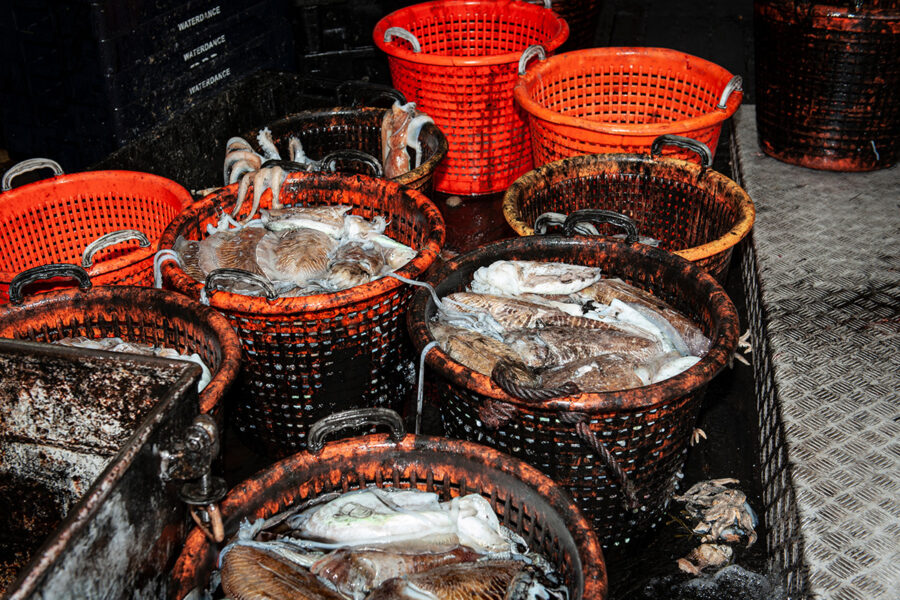18 species, a multitude of different fisheries, with a clear divide between Eastern and Western Channel fisheries, a 50:50 split with EU vessels, and local byelaws from six different IFCAs: this one is complicated
By Andy Read, Editor, Fishing News
The requirement in the Fisheries Act for the development of Fisheries Management Plans (FMPs) for all of the UK’s fisheries is tested to the core with the draft Channel Demersal Non-Quota Species (NQS) FMP.
Defra, which developed it, acknowledges that in reality it is going to see a range of plans within plans, reflecting the hugely diverse nature of the stocks and fisheries covered, and with a likelihood of different management measures being introduced in the Eastern and Western Channel.
The FMP covers eight fish species – bib/pouting, brill, lemon sole, turbot, John Dory, red mullet, and grey, red and tub gurnards; seven cephalopod species – common and elegant cuttlefish, common and curled octopus, and common and European squid; and three species of small shark – two species of smoothhounds that fishermen are reporting seeing in large quantities in the Eastern Channel and spotted dogs, increasingly landed along the coast for whelk bait.
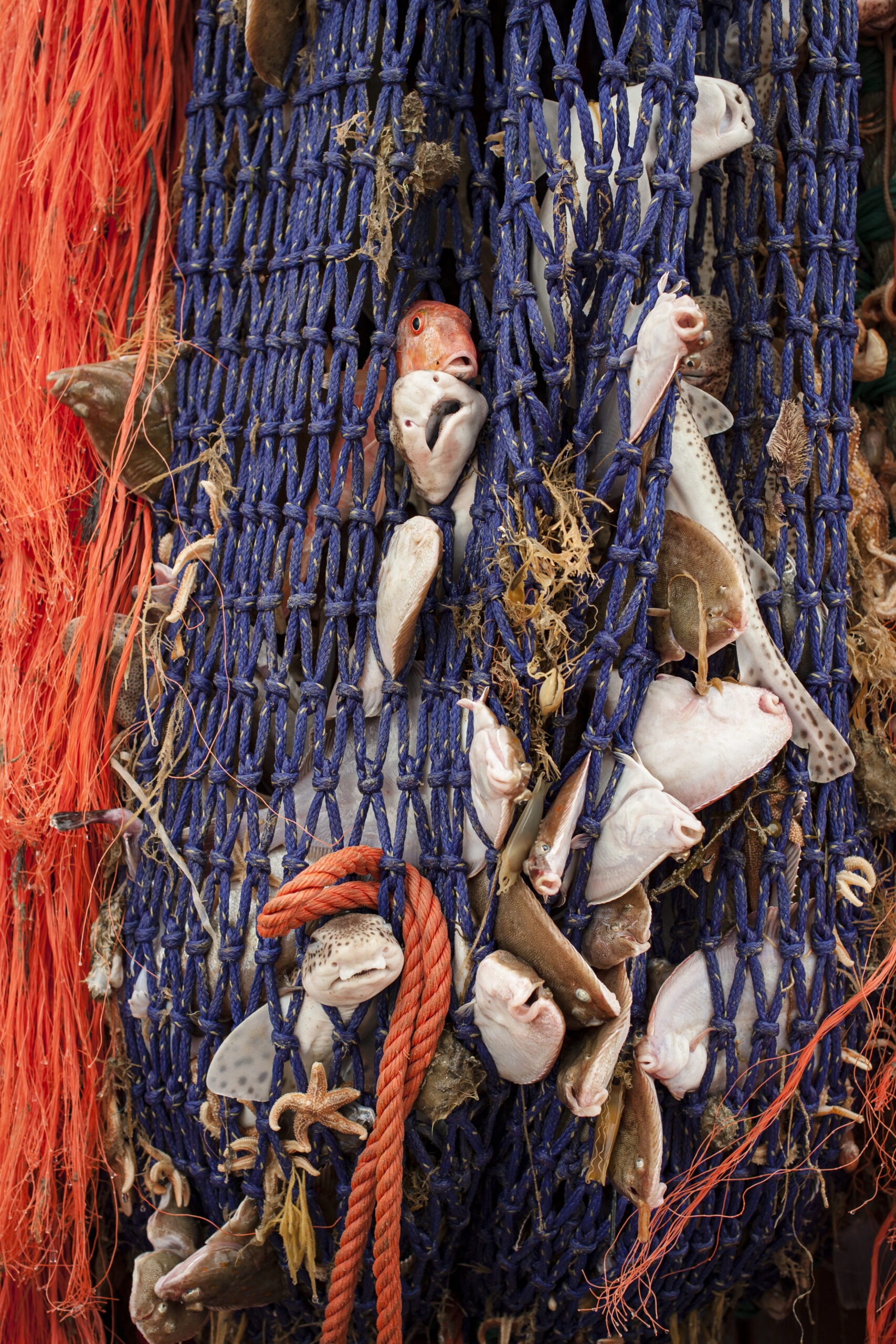
It’s not all about shellfish: gurnard, spotted dogs and lemon sole are all included in the draft NQS FMP, and are an important part of the mixed trawl fishery in the Channel for a range of small inshore day-boats. The increased numbers of smooth hounds being seen are prized in South East chippies and restaurants, although this demand seems to be restricted to this corner of the country. (Photo: Tony Fitzsimmons)
Most of the fish species are monitored by ICES, but are not given formal stock assessments. Whilst data indicates that these stocks are not being fished sustainably, it is only the red mullet fishery that has robust enough data to suggest that this is being overfished. The vast majority of the £4.44m landings recorded for the fishery in 2020 were into EU ports.
With the FMP encompassing the Brixham beam trawl fleet, large fly-shooters landing into EU ports, smaller inshore trawlers, and cuttlefish trap vessels that over the course of a year will also work with pots and gill-nets, decision-making will be further complicated by the fact that almost half the value of the NQS fishery in English waters is taken by visiting EU vessels, mainly French, for whom the Channel squid fishery is a vital part of their annual earnings.
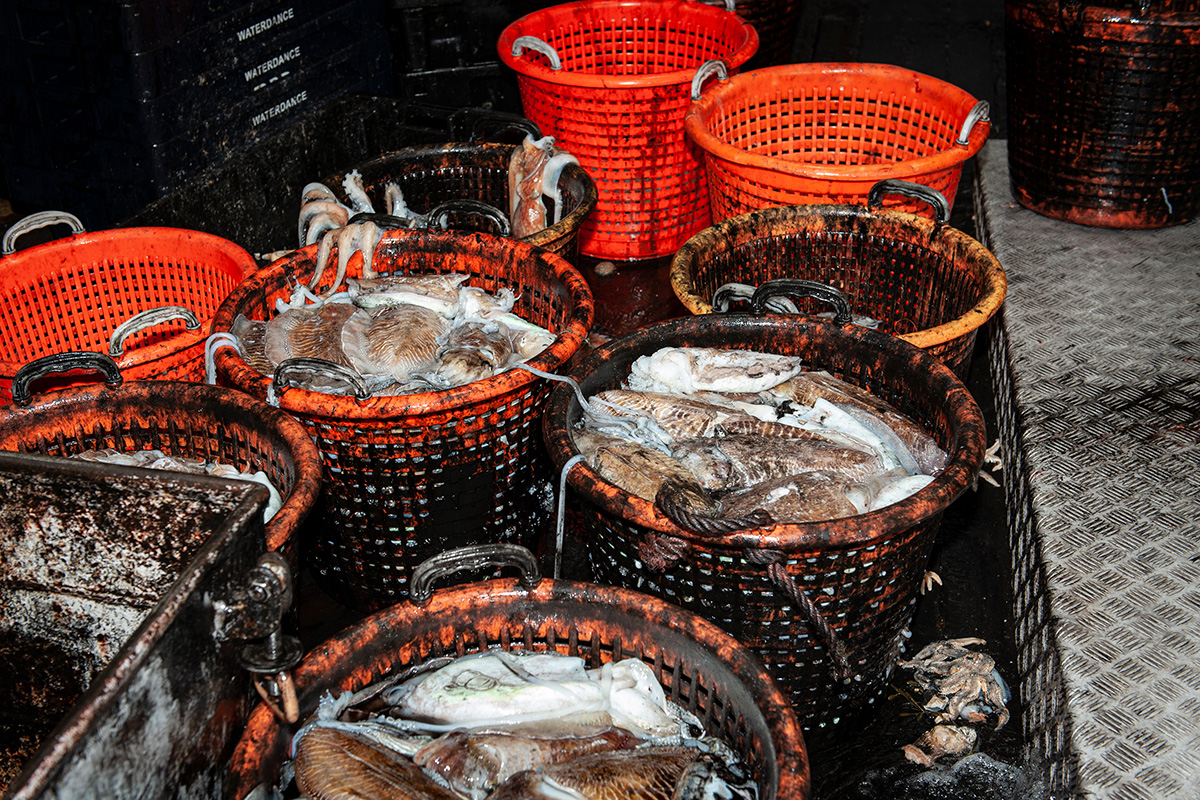
Black gold’ – with a few octopus in the background making the point about this being part of a mixed fishery – ready for washing and boxing on one of the Brixham beamers that rely on cuttlefish for a significant part of their annual fishing patterns. The value of cuttlefish landed into Brixham by the beam trawl fleet is more than all other landings of Channel non-quota species, in all UK and EU ports combined. (Photo: Tony Fitzsimmons)
Although a headline landing of 12,761t, valued at £33.1m, is quoted at the start of the consultation document for the NQS fisheries, later figures given are for 17,851t, estimated to generate landings with a first- sale value of £50m a year.
A third of the value of the fishery is ‘black gold’ – cuttlefish – primarily landed into Brixham, and a further 17% is squid, landed mainly by French trawlers, working with a derogation to use 40mm codends. The cephalopod fisheries are seen as a vital non-quota safety valve by many vessels, taking pressure off flatfish quotas in particular, which are not sufficient to sustain the beam trawl fleet for a full 12 months of the year.
A further level of complication is added by the TCA with the EU, which in theory provides an upper limit for non-quota species that can be caught by EU vessels in UK waters, and by the UK in EU waters, and the agreement reached in July that both parties would involve each other in developing management measures that would impact the other party.
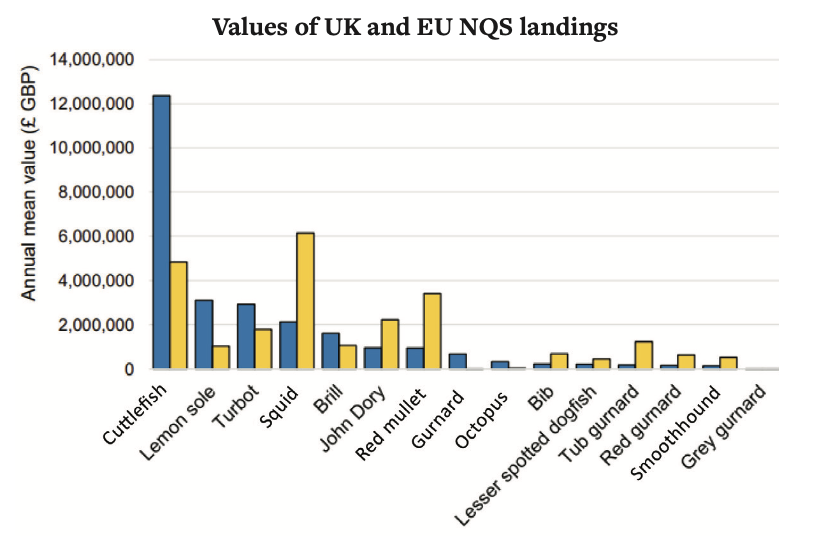
The values of UK (blue) and EU (yellow) landings of non-quota species from English waters of the Channel.
The consultation suggests five immediate actions, with the likelihood that it will be several years before wider data collection and understanding of the fishery will allow more detailed proposals. The consultation is as much about the process of developing these, as it is about possible changes to management.
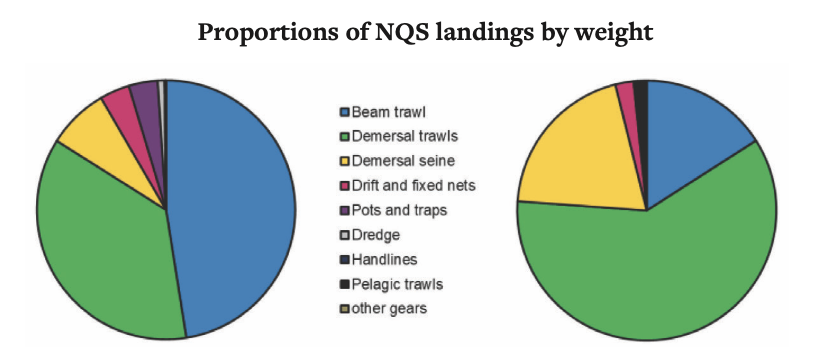
The proportions of landings, by weight, by UK (left) and EU vessels (right), by fleet segment. Beam trawls are the dominant method for UK vessels, whilst for EU vessels demersal trawl, followed by fly-shooting, are the most significant gear types.
The few concrete proposals made for the fisheries are:
- Fly-shooting: this was the subject of its own consultation, the results of which were then shifted to discussion within the FMP. It is proposed to remove the derogation for 40mm nets in the squid fishery, and make a minimum mesh size of 100mm mandatory across the fishery. A cap on engine power of 221kW is also proposed.
- Cuttlefish: a minimum size of 23cm is proposed for the fishery, as well as a seasonal closure to mobile gears, not just for landing cuttlefish, but to protect cuttlefish habitats. No dates or areas are suggested in the document itself.
- Minimum sizes: with several IFCAs already operating some minimum landings sizes for non-quota species, the consultation suggests introducing them across the whole of English waters in Areas VIId and VIIe – 25cm for lemon sole, and 30cm for brill and turbot. Minimum sizes for other target species in the fly-shooting fishery, such as red mullet and dab, should ‘be considered’.
- REM: given the lack of data, but with increasing concerns about stocks, the consultation proposes that the fly-shooting fleet is an early adopter of REM.
- Code of conduct: the FMP proposes that ‘codes of conduct for both commercial and recreational fishers’ be developed, ‘to improve the sustainability and benefits of the stocks for all sea users’. Quite what this entails or how they will be agreed is not explained.
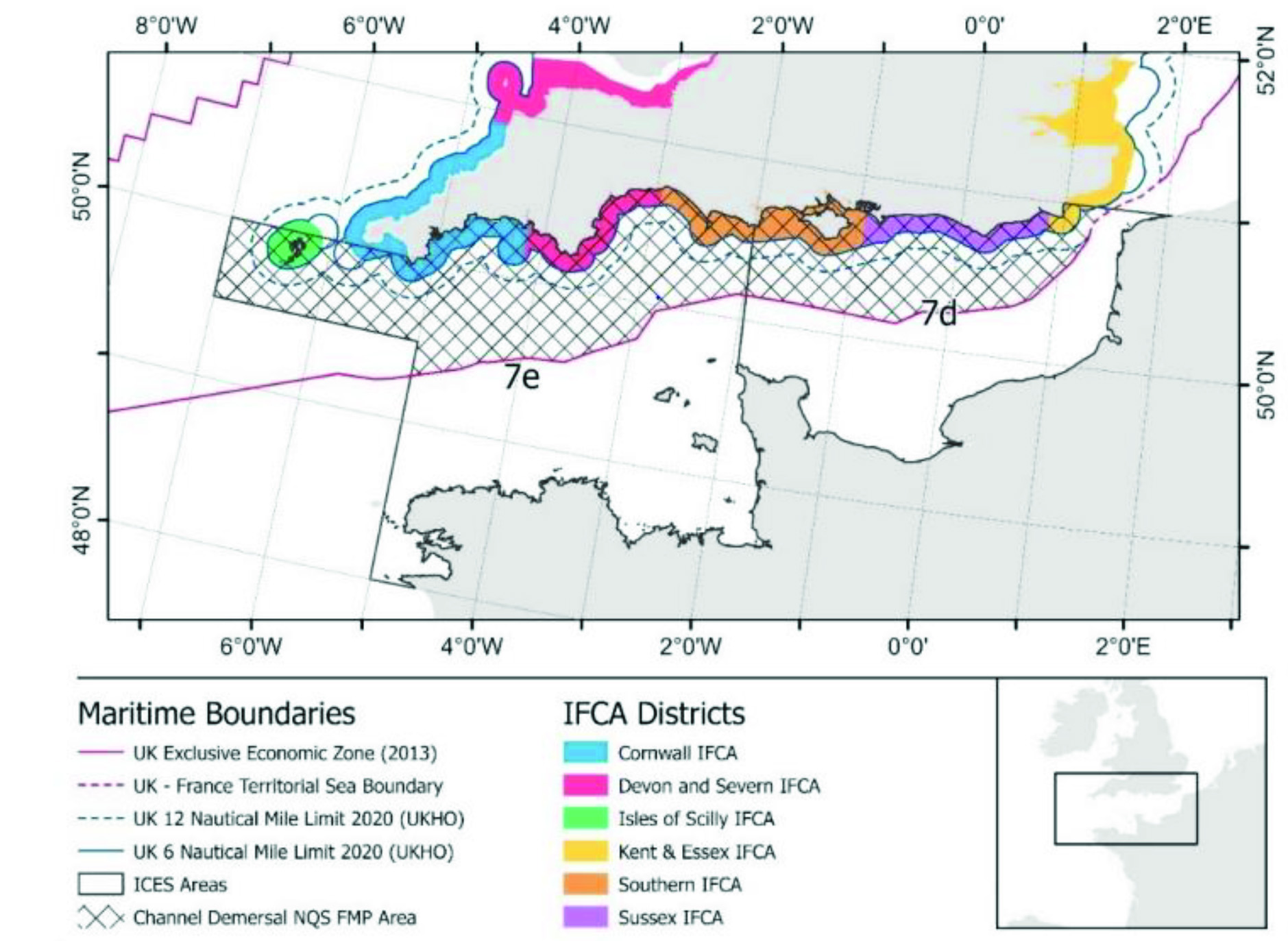
It’s complicated! Six IFCA districts are found within the Channel, many with their own regulations or byelaws. The Isles of Scilly IFCA district is set to expand considerably as a result of Brexit and the adoption of new baselines as soon as parliamentary time is made available to approve the necessary legislation. (Map: Collins Bartholomew, ICES and MMO)
Consultation questions
The main document – which is supported by no less than seven annexes and 220 pages, as well as separate impact and environmental assessments – is accompanied by a separate consultation questionnaire. As with the other FMPs, this focuses more on the development process and data in the fishery than it does on hard proposals for management.
There are only 10 questions, and in reality just three cogent questions are asked in relation to changing current management measures. These can be roughly summarised as:
- Do you agree with the proposed minimum landings sizes, and do you think any others should be introduced?
- Do you support the introduction of seasonal closures for mobile gears in the cuttlefish fishery? If so, when, where and how?
- What other management measures do you think need to be introduced?
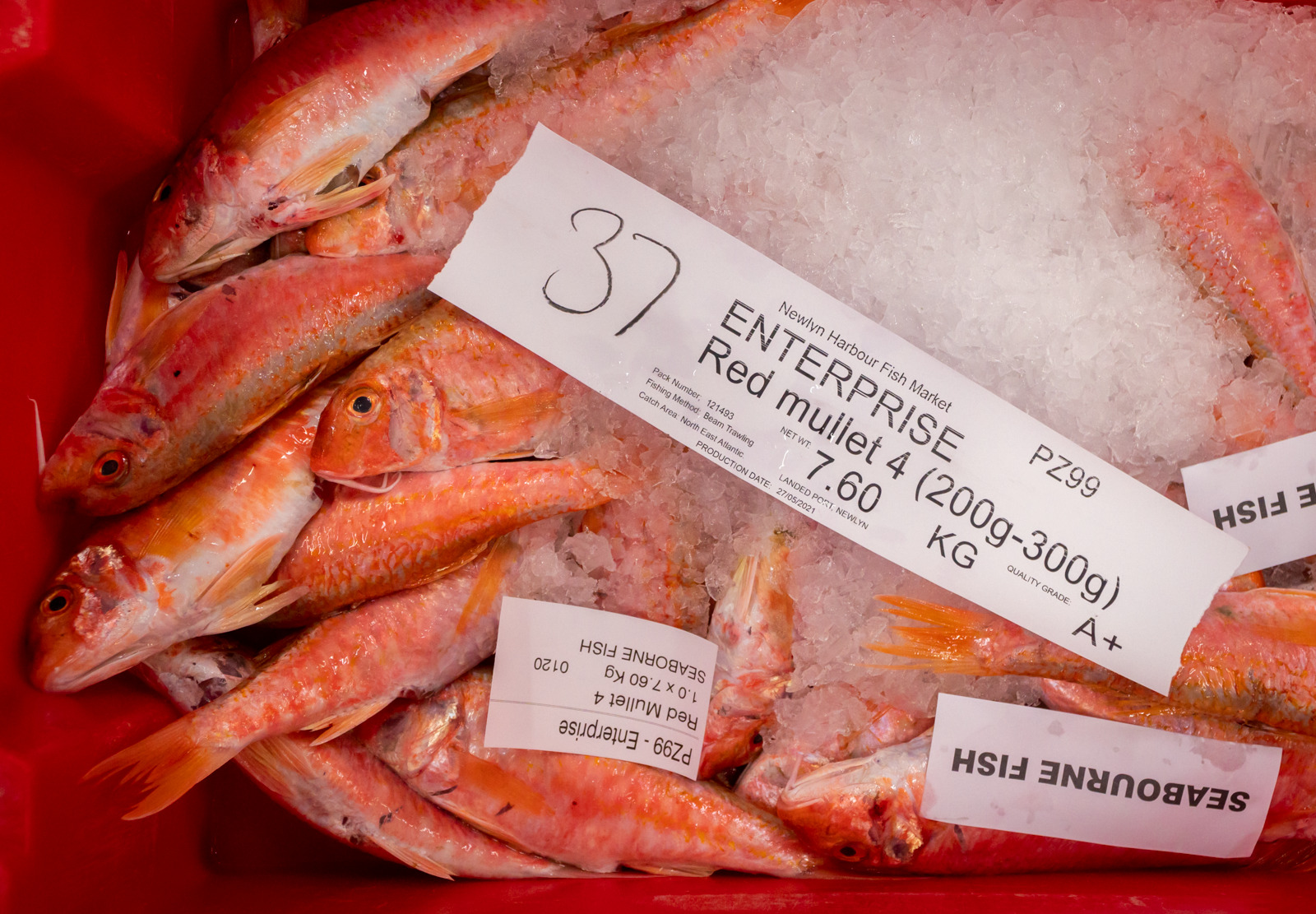
Red mullet is amongst the most valuable of the non-quota species within the plan, with prices for the very largest fish sometimes reaching £20/kg. The majority of catches made in the Channel, however, are landed into EU ports, either by the French fleet, or by Dutch-owned fly-shooters fishing on the UK flag. (Photo: Laurence Hartwell)
So whilst those with an interest or stake in the fishery may not want to read more than 300 pages of documentation, there is little excuse for not responding at all. Defra has made it as easy as possible, even if any comments outside the main line of questioning – your thoughts about the fly-shooting proposals, for example – will need to be typed in at the end of the document.
The consultation, and supporting documentation, can be found here.
‘We need the science’
NFFO chair says it is vital that FMPs are led by good science and complement each other – and that management must not be fragmented by stricter rules within IFCA districts
The NFFO has in membership vessels that cover virtually all the huge variety of fisheries covered under the NQS FMP. Due to the resulting range of contrasting views, it is challenging for the federation to make detailed proposals on behalf of its members – but NFFO chairman Paul Gilson, who has a lifetime of experience at sea within many of the fisheries covered by the FMP, shared his own views on the consultation with FN.
Acknowledging the issues where different sectors of the fleet had differing views and priorities, Paul Gilson said: “Overall, we have to welcome the moves by Defra to develop FMPs, and it’s vital as an industry that we respond to each and every one.
“There are undoubtedly some good proposals being discussed in the various consultations, though one fear I do have is that between them, the FMPs can contradict each other. What we can’t have is rules from one dominant and important fishery coming in and covering activities in another FMP.
“I see a real danger, too, with the potential for so many IFCAs to bring in different, or additional, rules that will be on top of those agreed for the FMP as a whole. We can’t have a situation where on the one hand, we have Defra and the MMO consulting on sensible management rules for our fisheries, and on the other IFCAs bringing in their own set of rules that are undermining local fleets, with minimal accountability. It is vital that in all these fisheries, we have a single tier of management, applicable across the board.
“The inshore fleet in the Channel right now is in disarray. You only need to look at Find a Fishing Boat to see the number of vessels up for sale, simply looking for ‘offers’. There is so much disillusionment. I very much hope that development of the FMPs is a way to reverse some of this, with Defra and MMO taking the lead and not letting IFCAs penalise inshore vessels simply because they are more reliant on fishing inside six miles.
“The NQS FMP is a tough one – within the NFFO we have members undertaking every type of fishing, from large vessels to small. What is vital is that we recognise the common need for science-based decisions, and don’t select one group of fishermen over another as the primary beneficiary of the rules. It’s so important that decisions here are driven by data, and not emotion.
“With half the landings from the NQS fishery going into EU ports, and considerable interest by anglers in some species, that often end up on restaurant tables, we also need to ensure that the rules developed are enforceable.
“A decision on the cuttlefish fishery and MLS has, in my view, to be driven by the best science. The species only lives for a year. Does its size depend largely on the availability of food, affecting growth rates, in which case MLS may not be as helpful as we think? What is the earliest point of the year that spawning starts in the Eastern and Western Channel?
“I’d be interested in detailed scientific advice about a species that has been a rare success story for fishermen who are struggling in many cases with a lack of other traditional fisheries.
“The consultation questions themselves are short and to the point, and whilst there is scope to add your own thoughts, my message to fishermen, at the risk of sounding like a stuck record, is: ‘Have your say.’ We’ve been offered the chance to make our opinions known. My own discussions with politicians, Defra and the MMO suggest that they are approaching these exercises with an open mind, and we have a real opportunity here to have an influence on how our fisheries are managed in future years.”
Cuttlefish MLS proposal: ‘a huge impact on everyone’
Brixham, by far and away the most important landings port for cuttlefish, also sees additional landings sold at auction after overland transport from ports across the south coast, from both potters and mobile-gear boats.
Barry Young, managing director of Brixham Trawler Agents, talked FN through the importance of the species both to the Brixham fleet and market and to a wide range of smaller ports and buyers. Changing the MLS, he said, could have a huge negative impact on the fishery without providing the perceived benefits of the proposal.
“We can’t overstate the importance of cuttlefish to Brixham and the fishing industry as a whole,” he said. “It’s a mainstay of a large portion of the fleet for several months, not just beamers as some people think.
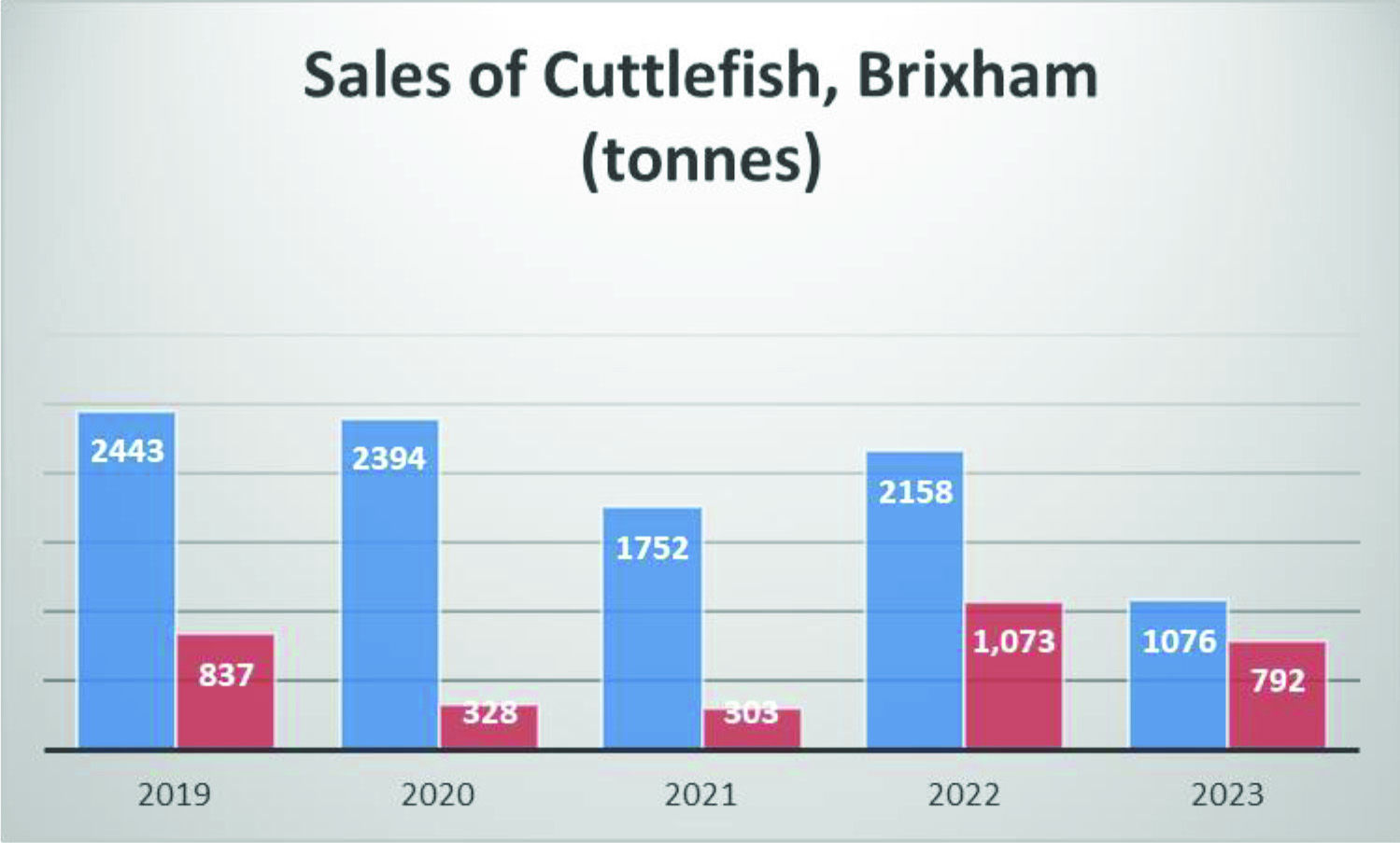
Sales of large (blue) and small/medium (red) cuttlefish on Brixham market.
“The market itself has staffing levels and facilities that have grown up around the fishery and are highly dependent on it. We’ve just taken on five new staff purely for weighing and sorting the cuttlefish, which needs a team of 10 to get through the busy period.
“We have three or four significant large local processors who bid for the landings on the auction, as well as a French processor who buys remotely and a rapidly growing interest as well from processors in the Netherlands. There is interest in all the cuttlefish we get in, whether it is large fish overland from the potters in the Eastern Channel, or smaller fish at the start of the season – although there is always a price differential paid for the larger sizes.

The relative values of the two size classes. The market cut-off point between the two is a weight of around 500g, which corresponds to a length of around 15cm. The FMP proposes to raise this to 23cm, in addition to some sort of seasonal closures to protect young cuttles and potentially their spawning grounds.
“In a ‘traditional’ year, we would start to see the cuttles coming in from the Western Channel in late August or early September. These were generally uniform size, starting small/medium, and then as the season progressed rapidly growing larger, with fish over 500g each, around 16cm, classed as large and bringing in better prices.
“But more recently, we’ve seen a real mix of sizes coming in to the market for sale. Larger fish mixed in with smaller fish, across the season. It’s been strange – almost as if we are seeing two year-classes, although we’re told the animals only live a season and die after they’ve spawned.
“It is going to have real implications for the fishery if the 23cm MLS comes in. Whilst it sounds sensible in theory to let smaller fish grow and take them later in the season, this may well see a big increase in discarding, when we have such a mix of size ranges apparent in the catches.
“The beamers won’t have alternative fisheries during this season, and with high catch rates of larger cuttles, and increasing demand, they will still fish for them. And on top of that, we’re all aware of the interactions with other species, and the fact that cuttlefish are really effective predators! There are concerns about delaying the fishery purely due to the amount of other species they’ll eat in the interim.
“This will be the case, looking at the size ranges we’ve had in the most recent years, even if the season is knocked back from the end of August to October, when we’d expect the cuttles to be predominately large. So I’m not sure that the raised MLS will provide the benefits that at first glance it looks it will provide.”
This story was taken from the latest issue of Fishing News. For more up-to-date and in-depth reports on the UK and Irish commercial fishing sector, subscribe to Fishing News here or buy the latest single issue for just £3.30 here.
Sign up to Fishing News’ FREE e-newsletter here.

